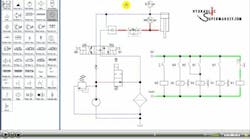If you read my previous blog post about hydraulics troubleshooting, you'll recall I told the story of a monkey caught in an old Indian monkey trap. This story was an analogy for the importance of both knowledge AND process for a successful troubleshooting outcome. In response, Bill Smith sent me this:
"That is a great analogy. I am a USAF civilian (USAF retired) and work with military aircraft technicians as a field rep. I constantly hear from peers and leaders that personnel need system knowledge training and that is the end all to solve all troubleshooting problems. I have been trying to emphasize that the PROCESS and approach to troubleshooting is nearly as, or more important than, specific knowledge of a system.
I use the guitar as analogy for this. I can show a student the guitar, teach her where every note lies on the neck and strings, show her how it is constructed and so on, until they know everything about a guitar. Then I can hand it to them and say: "now play it" -- knowing full well they can't.
This is the difference between knowledge and expertise. Knowledge can be taught but expertise must be developed through practice. HOWEVER, if someone teaches you a PROCESS your practice is more effective and you fast track your way to expertise."
I couldn't agree more. Hydraulics system knowledge is a great advantage when troubleshooting. But without a reliable process, it's very easy for the troubleshooting effort to become hit and miss. But perhaps more importantly though, a reliable process often leads to the discovery of the knowledge required to solve the problem.
Case in point is the monkey caught in the trap. Even absent any knowledge about how the trap works, he CAN still figure it out. But only if he understands the troubleshooting process, and applies it correctly.
In The Hydraulic Troubleshooting Handbook, I outline and explain a 12-step troubleshooting SYSTEM that begins with checking the easy things first. The temptation of many is to dismiss this essential first step as too basic to be useful. But before YOU do so, consider that a colleague of mine in the hydraulics repair biz has calculated that over a period of 20 years his business has earned in excess of $2-million from service calls which were resolved in one of two ways:
- adding oil to the hydraulic tank; and
- adjusting the system relief valve correctly.
This helps to explain why hydraulics troubleshooting expertise is highly valued and sought after. It also telegraphs the fact that it's not too hard to look good at this; even a modest amount of hydraulics troubleshooting expertise can take you a long way.
Bottom line: failing to follow a reliable SYSTEM when troubleshooting can result in costly mistakes. And to discover six other costly mistakes you want to be sure to avoid with your hydraulic equipment, get "Six Costly Mistakes Most Hydraulics Users Make... And How You Can Avoid Them!" available for FREE download here.

